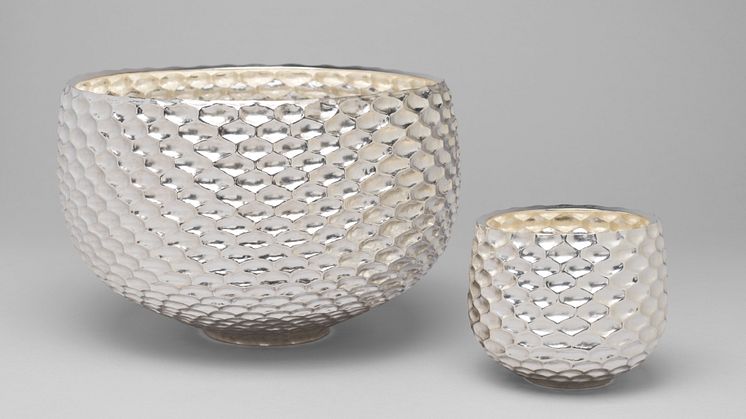
Press release -
Silver craft gift from the Ulf Gillberg – Lennart Agerberg Foundation to Nationalmuseum
Nationalmuseum has received a generous donation from the newly formed Ulf Gillberg – Lennart Agerberg Foundation. The gift is the Big and Small Bowl from 2019 by the Danish silversmith Carsten From Andersen. The Foundation desires to promote the purchase of contemporary silver objects to Nationalmuseum, which will provide the museum with greater possibilities to reflect developments within contemporary silversmithing.
The Ulf Gillberg – Lennart Agerberg Foundation is a very generous private initiative that commenced its activities in 2020. The purpose of the foundation is to promote the purchase primarily contemporary objects of silver, excluding jewellery, made by both Swedish and foreign silversmiths to be added to Nationalmuseum’s collections. The acquisitions will preferably be made directly from the silversmiths or their gallerists. The co-founders of the foundation are especially interested in the connection between the hand and the brain in the creation process, and hope to be able to contribute to the development and survival of the craft. An additional purpose of the foundation is to promote scientific research related to the focus of the collection. The board of the foundation includes Lennart Agerberg (Chair), Ulf Gillberg, Anders Lundin (The Friends of the Nationalmuseum), Eva Qviberg and Micael Ernstell (Nationalmuseum). The gifts will be donated to the Nationalmuseum via The Friends of the Nationalmuseum.
The first gift that the foundation has acquired for Nationalmuseum was crafted in 2019 by the Danish silversmith Carsten From Andersen (born 1946) and is called the Big and Small Bowl. The two bowls have been formed with many, carefully placed, hammer blows. The material used is fine silver containing only 0.1 % copper, differentiated with sterling silver which contains 7.5 % copper in the alloy, which is most common in these contexts. The pure silver is softer to work with and also visually gives a softer feel. Due to that it contains less copper, it does not oxidise so quickly. On the other hand the high silver content affects the price and the uniqueness.
“Given the co-founders interest in the importance of the hand, the choice of a work of art from Carsten From Andersen is only natural. The silversmith has very solid and extensive experience, and allows himself to be inspired nature, especially by stones. With this knowledge one can read the bowls in a different way. The surface consists of many individual “casts” of stones, laboriously crafted with hammers made from a variety of different materials,” says Micael Ernstell, curator specialising in applied art and design at Nationalmuseum.
Carsten From Andersen graduated as a silversmith in Frederica in 1969 and in 1987 in Copenhagen as a goldsmith. Carsten From Andersen received 1st Prize in the 2019 HammerClub Award in Dundee in Scotland for the bowls now being donated. HammerClub – Platform for Silversmithing is an international forum for silversmiths and silver enthusiasts that was initiated in 2002. Every year a symposium is held with lectures and workshops along with an exhibition in a particular chosen city.
Nationalmuseum receives no state funds with which to acquire design, applied art and artwork; instead the collections are enriched through donations and gifts from private foundations and trusts. The acquisition has been made possible by a kind donation from the Ulf Gillberg – Lennart Agerberg Foundation.
Inventory number:
Carsten From Andersen, Big and Small Bowl, 2019. 999 pure silver. NMK 149A+B/2020.
For further information contact
Micael Ernstell, Curator Applied Art and Design, micael.ernstell@nationalmuseum.se, 08-5195 4392
Hanna Tottmar, Head of Press, press@nationalmuseum.se, +46 (0)8-5195 4400
Categories
Nationalmuseum is Sweden’s museum of art and design. The collections include paintings, sculpture, drawings and graphic art from the 16th century up to the beginning of the 20th century and the collection of applied art and design up to the present day. The museum building closed for renovation in 2013 and reopened in autumn 2018.

